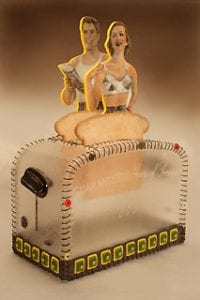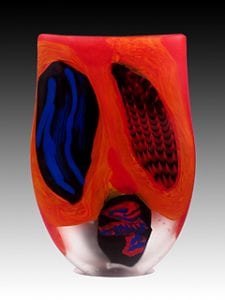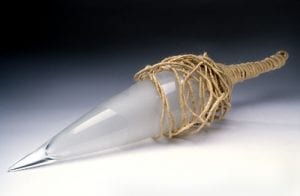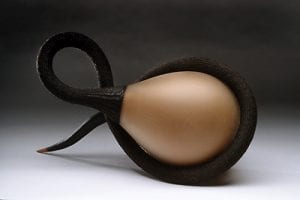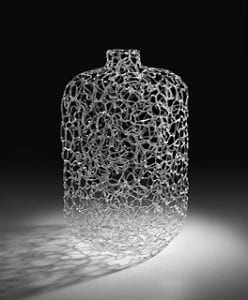
- This event has passed.
GLASS CONCEPTS
February 13, 2008 - April 13, 2008
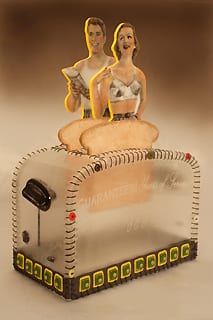
Susan Taylor Glasgow, Noel Hart, Tevita Havea, Thérèse Lahaie, Ann Wolff, Brent Kee Young. Contemporary sculptural designs in glass. Co-curated by Peggy W. Hobbs and Dzintra Kalnins.
CURATORIAL STATEMENT
Glass Concepts presents works of artists from a broad range of innovative techniques and aesthetic sensibilities, offering expressions in glass as a sculptural medium to explore personal passions.
ARTISTS
Susan Taylor Glasgow was born in Superior, Wisconsin in 1958 and grew up in Duluth, Minnesota. She graduated from the University of Iowa in 1984 with a BFA in Design, and now lives and works in Columbia, Missouri.
“I embraced domesticity in feminine spirit but not in action. Misguided domestic talents eventually grew into concepts of sewing an unyielding medium, baking inedible creations, and stitching glass clothing no one can wear. I cook, arrange, and sew glass. My life and art are the result of homemaking skills gone awry.
“Each sculpture starts out as flat sheets of glass. To establish the three-dimensional shape and holes, each section is kiln-fired several times. The text and figures are sandblasted into the glass; and pigment rubbed into the sandblasted area to create the black and gray “photo.” The components are then fired again to 1250 degrees to melt the pigment into glass. Once cooled, the sections are cold-worked, given a final sandblasting, and then assembled.”
Noel Hart lives in a sub-tropical rain forest in the northern part of New South Wales, Australia, an area where other species outnumber him. Hart’s glass sculptures are abstracted portrayals of wild parrots from around the world, and particularly the many species that surround him. The unusual effect of his work is created by acid etching the surface of his artworks at the end of the process so that they have a matte finish instead of the usual glossy appearance of most glass. Hart holds a Diploma of Fine Art and Design, 1975, from Gordon Institute of Technology in his hometown of Geelong, Australia.
“Shape upon shape, colour over colour, form over form and looking somehow to create an image that’s full of a parrot… The focus of my artwork is a consuming passion for an abstract or semi-abstract personal iconography, reflecting an interest in nature and ecology. I’m fortunate to have a continuous experience with biodiversity, a relationship I constantly refer to in my artwork through texture and bright colour of plumage of parrots. A passion and involvement with photography, theater and painting has added a dimension of design form to this view of art.”
Tevita Havea is a contemporary artist who was born in the Tonga Islands of New Zealand and moved to Sydney, Australia at the age of ten. He studied visual art at the Australian National University School of Art, majoring in glass and sub-majoring in sculpture. He graduated in 2005.
Since childhood he has been an artist-in-waiting by his early immersion in the flourishing cultural environment of his native Tonga. His early island years spent with his grandmother have had the most impact on Havea’s aesthetic sense of the world. He grew up amidst traditional craft and ritual, his boyhood imagination nutured on ancient myths and legends.
“I am interested in the idea of re-birth and I’m influenced by myth, legends, and rituals from the ancient world. Stories of creation and re-creation have been with me for as long as I can remember, it is part of me and it feeds my work.”
A self-proclaimed “Contemporary Primitive” he says,” I find myself in-between worlds. There are always contradictions when there are two opposing forces, but instead of one dominating the other, I aim to make pieces that are neither ancient nor contemporary, but operate to explore the tensions of the space between.”
The Polynesian reference is deliberately blurred in order to address the more primal question of universal humanity. The weaving is not a decorative device. In Polynesian culture, women weave, men carve. A man weaves only out of practical necessity, for construction purposes, and it is in this context that Havea uses the hemp: to bind the wood and glass. The wood alludes to traditional craft and custom, the glass represents the temporal. He only uses materials that have particular connotations, never for the sake of it.
Thérèse Lahaie changed from a career as anatomist/illustrator to glass sculpture, and was inspired by medieval stained glass windows in European cathedrals. She received a BFA from the Massachusetts College of Art in 1986. In 1987 she moved to the Bat Area of San Francisco and her work became dominated by images related to navigation. For an exhibtion entitled “Glass, Linking Art and Science” at the MIT Museum, her work began to rock with kinetic movements, powered by a small motor. in 2006 she received a Djerassi R Fellowship in Woodside, CA. He second solo show presented at the Heller Gallery, New York, in the Spring of 2007.
“We are always on the verge of the next movement, breath, gesture, cycle.” In this series of kinetic sculptures, the artist animates glass, demonstrating its affiliations with light, water, and air. In an unusual combination of glass, steel, motors and fabric, the visual vocabulary speaks in the larguage od science, the natural world, and contemplative practice. The mesmerizing waves evoke both seascape and landscape in a subtle erotic dance. Viewers are invited to not only to look at the pieces, but to connect to their own rhythms of heartbeat and breath.
German-born Ann Wolff has worked in art for almost 45 years. She studied visual communications at the School of Design in Ulm, Germany from 1956 to 1959. She moved to Sweden in 1960 to work for Pukeberg and Kosta Boda manufacturers. In 1978 she left the glass industry to set up her own studio and since 2000 has had studios in Gotland and Berlin were she creates large sculptural works.
Wolff’s relationship to glass has always been complicated, in part because her approach to art has always been complex, marked by a fierce commitment to exploration and experimentation. What interested her most was engaging in what she describes as a battle with the material. “Very early I tried to get spontaneity into glass, scooped it up, allowed it to flow freely, put obstacles in its way, molded structures into it, blew it and poured it into water, mud, snow, remodeled it, changed it’s state, meanwhile dipping it into dark enamel — all in order to allow it to go in unpredictable ways.”
In 1989 she turned to drawing, but of late has concentrated on kiln-casting, which has reinvigorated her work. Wolff has always been interested in the concept of self and identity; the single face enclosed in large blocks, she says, “own special solitude. They are imprisoned in glass.” She often presents figures with masks, that exemplary motif of the mysteries of private and public selves.
Both the abstract and the figurative are important to her, and she embraces both modes, and describes herself as “a traditional modernist.”
Brent Kee Young was born in 1946. He received a BFA at San Jose State and MFA from Alfred University and subsequently headed the establishment of the first glass program in a national university in Kariya, Japan. He is currently Professor and Chairman of the Glass Department of the Cleveland Institute of Art in Ohio. Early works addressed the vessel and skeletal images. the present work shown here is of the “Matrix” series that is represented in the Smithsonian/Renwick Gallery, the Toledo Museum, and the Corning Museum among others. A juror for the National Endowment for the Arts, he teaches frequent workshops in the U.S. and abroad.
“I am interested in the ambiguous nature of glass and the sense of space and volume one can create. Often informed by our natural world, these works offer a new approach to working with and perhaps solving those mysteries.” Forms swirl and float within flame-worked Corning Pyrex glass. The works create a visual pattern of an intricately layered glass web to form unique and technically complex structures. They are fashioned in a way to form an organic interconnected lattice in which almost any shape might be realized. The narrative-based structures are entirely linear with no solid mass; they are geometric form within geometric form. Each presents a delicate balance of slender twigs of clear glass.
GALLERY TALK: James Harmon: “Glass Concepts”: Spring 2008
